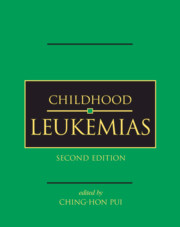Book contents
- Frontmatter
- Contents
- List of contributors
- Preface
- Part I History and general issues
- Part II Cell biology and pathobiology
- Part III Evaluation and treatment
- Part IV Complications and supportive care
- 29 Acute complications
- 30 Late complications after leukemia therapy
- 31 Therapy-related leukemias
- 32 Infectious disease complications in leukemia
- 33 Hematologic supportive care
- 34 Pain management
- 35 Psychosocial issues
- 36 Nursing care
- Index
- Plate Section between pages 400 and 401
- References
30 - Late complications after leukemia therapy
from Part IV - Complications and supportive care
Published online by Cambridge University Press: 01 July 2010
- Frontmatter
- Contents
- List of contributors
- Preface
- Part I History and general issues
- Part II Cell biology and pathobiology
- Part III Evaluation and treatment
- Part IV Complications and supportive care
- 29 Acute complications
- 30 Late complications after leukemia therapy
- 31 Therapy-related leukemias
- 32 Infectious disease complications in leukemia
- 33 Hematologic supportive care
- 34 Pain management
- 35 Psychosocial issues
- 36 Nursing care
- Index
- Plate Section between pages 400 and 401
- References
Summary
Introduction
Because cure rates for children with acute lymphoblastic leukemia (ALL) have improved over the last three decades, information concerning late treatment sequelae has become increasingly important. Earlier reports described long-term complications after relatively homogeneous, less intensive chemotherapy given with cranial or craniospinal irradiation for central nervous system (CNS) preventive therapy. Recognition of new prognostic clinical and biological features has permitted risk-directed treatment that now cures at least 70% of children with ALL. Continued surveillance of the survivor population will elucidate the sequelae of these modern, intensive therapies.
Similarly, the long-term survival of children with acute myeloid leukemia (AML) has improved substantially in the last decade with the use of more intensive chemotherapy regimens and allogeneic bone marrow transplantation. Today, approximately 40% of children with AML are cured of their disease. The increasing numbers of long-term survivors of AML mandate the evaluation of late treatment sequelae and their effect on morbidity and mortality.
This chapter presents a systematic review of late treatment complications of childhood acute leukemia. My purpose is to assist the reader in identifying treatment and patient characteristics that predict the risk for adverse sequelae. Once these risk features are recognized, appropriate surveillance studies can be undertaken, and the potential effects of various therapy-related complications can be addressed during the design of future treatment regimens.
- Type
- Chapter
- Information
- Childhood Leukemias , pp. 750 - 773Publisher: Cambridge University PressPrint publication year: 2006



